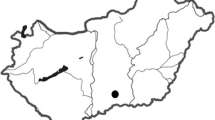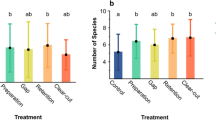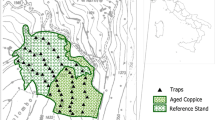Abstract
Plantation forests comprise an important part of the forested areas in European countries. Intensive forestry management and short-rotation cycles of plantation forests reduce habitat diversity and change the composition of invertebrate assemblages, mainly by reducing the number of habitat specialist species. Here, we analysed the effect of vegetation structure, amount of dead organic matter (DOM) and plantation age on spider functional diversity and assemblage structure in short-rotation plantations of native silver poplar in Hungary. Three stages, representing young plantations, 6- to 10-year-old stands (five stands), middle-aged plantations, aged between 23 and 26 years (five stands) and mature, 35- to 37-year-old forests at commercial maturity (five stands) were sampled. Each sample consisted of the data of ten pitfall traps. Traps were installed 5 m from each other in a 2 × 5 grid. Functional diversity was positively related to vegetation structure. High functional diversity indicates a higher number of available niches and potential resources. The abundance of moist habitat species and forest specialist species was positively correlated with DOM. Furthermore, moist habitat species were also related to vegetation structure. The most important environmental parameters affecting spiders were factors attributed to trees (litter and DOM), understory vegetation structure and, to a lesser extent, forest age. Different-aged stands may be similar in terms of species composition of their spider fauna if they comprise the same habitat structural patterns. Our study emphasises that the simple habitat structure of plantation forests has a negative effect on spider communities.


Similar content being viewed by others
References
Allegro G, Sciaky R (2003) Assessing the potential role of ground beetles (Coleoptera, Carabidae) as bioindicators in poplar stands, with a newly proposed ecological index (FAI). For Ecol Manag 175:275–284. doi:10.1016/S0378-1127(02)00135-4
Ammer S, Weber K, Abs C, Ammer C, Prietzel J (2006) Factors influencing the distribution and abundance of earthworm communities in pure and converted Scots pine stands. Appl Soil Ecol 33:10–21. doi:10.1016/j.apsoil.2005.09.005
Baker SC, Spies TA, Wardlaw TJ, Balmer J, Franklin JF, Jordan GJ (2013) The harvested side of edges: effect of retained forests on the re-establishment of biodiversity in adjacent harvested areas. For Ecol Manag 302:107–121. doi:10.1016/j.foreco.2013.03.024
Barsoum N, Fuller L, Ashwood F, Reed K, Bonnet-Lebrun AS, Leung F (2014) Ground-dwelling spider (Araneae) and carabid beetle (Coleoptera: Carabidae) community assemblages in mixed and monoculture stands of oak (Quercus robur L./Quercus petraea (Matt.) Liebl.) and Scots pine (Pinus sylvestris L.). For Ecol Manag 321:29–41. doi:10.1016/j.foreco.2013.08.063
Bell JR, Bohan DA, Shaw EM, Weyman GS (2005) Ballooning dispersal using silk: world fauna, phylogenies, genetics and models. Bull Entomol Res 95:69–114. doi:10.1079/BER2004350
Blandenier G (2009) Ballooning of spiders (Araneae) in Switzerland: general results from an eleven-year survey. Arachnology 14:308–316. doi:10.13156/arac.2009.14.7.308
Brockerhoff E, Jactel H, Parrotta J, Quine C, Sayer J (2008) Plantation forests and biodiversity: oxymoron or opportunity? Biodivers Conserv 17:925–951. doi:10.1007/s10531-008-9380-x
Buchar J, Ruzicka V (2002) Catalogue of spiders of the Czech Republic. Peres, Prague
Buddle CM, Spence JR, Langor DW (2000) Succession of boreal forest spider assemblages following wildfire and harvesting. Ecography 23:424–436. doi:10.1111/j.1600-0587.2000.tb00299.x
Buddle CM, Langor DW, Pohl GR, Spence JR (2006) Arthropod responses to harvesting and wildfire: implications for emulation of natural disturbance in forest management. Biol Conserv 128:346–357. doi:10.1016/j.biocon.2005.10.002
Bultman TL, Uetz GW (1982) Abundance and community structure of forest floor spiders following litter manipulation. Oecologia 55:34–41
Castro A, Wise DH (2010) Influence of fallen coarse woody debris on the diversity and community structure of forest-floor spiders (Arachnida: Araneae). For Ecol Manag 260:2088–2101. doi:10.1016/j.foreco.2010.08.051
Chamberlain PM, McNamara NP, Chaplow J, Stott AW, Black HI (2006) Translocation of surface litter carbon into soil by Collembola. Soil Biol Biochem 38:2655–2664. doi:10.1016/j.soilbio.2006.03.021
Chen B, Wise DH (1999) Bottom-up limitation of predaceous arthropods in a detritus-based terrestrial food web. Ecology 80:761–772. doi:10.1890/0012-9658(1999)080%5B0761:BULOPA%5D2.0.CO;2/full
Coote L, French LJ, Moore KM, Mitchell FJG, Kelly DL (2012) Can plantation forests support plant species and communities of semi-natural woodland? For Ecol Manag 283:86–95. doi:10.1016/j.foreco.2012.07.013
Corcuera P, Valverde PL, Jiménez ML, Ponce-Mendoza A, De la Rosa G, Nieto G (2015) Ground spider guilds and functional diversity in native pine woodlands and eucalyptus plantations. Environ Entomol. doi:10.1093/ee/nvv181
Elek Z, Dauffy-Richard E, Gosselin F (2010) Carabid species responses to hybrid poplar plantations in floodplains in France. For Ecol Manag 260:1446–1455. doi:10.1016/j.foreco.2010.07.034
Entling W, Schmidt MH, Bacher S, Brandl R, Nentwig W (2007) Niche properties of Central European spiders: shading, moisture and the evolution of the habitat niche. Glob Ecol Biogeogr 16:440–448. doi:10.1111/j.1466-8238.2006.00305.x
Evans AM, Clinton PW, Allen RB, Frampton CM (2003) The influence of logs on the spatial distribution of litter-dwelling invertebrates and forest floor processes in New Zealand forests. For Ecol Manag 184:251–262. doi:10.1016/S0378-1127(03)00158-0
Gallé R (2008) The effect of a naturally fragmented landscape on the spider assemblages. North-West J Zool 4:61–71
Gallé R, Torma A (2009) Epigeic spider (Araneae) assemblages of natural forest edges in the Kiskunság (Hungary). Community Ecol 10:146–151. doi:10.1556/ComEc.10.2009.2.2
Gallé R, Maák I, Szpisjak N (2014a) The effects of habitat parameters and forest age on the ground dwelling spiders of lowland poplar forests (Hungary). J Insect Conserv 18:791–799. doi:10.1007/s10841-014-9686-9
Gallé R, Kanizsai O, Ács V, Molnár B (2014b) Functioning of ecotones-spiders and ants of edges between native and non-native forest plantations. Pol J Ecol 62:815–820. doi:10.3161/104.062.0404
Gallé R, Erdélyi N, Szpisjak N, Tölgyesi C, Maák I (2015) The effect of the invasive Asclepias syriaca on the ground-dwelling arthropod fauna. Biologia 70:104–112. doi:10.1515/biolog-2015-0011
Irwin S, Pedley S, Coote L, Dietzsch A, Wilson M, Oxbrough A, Sweeney O, Moore K, Martin R, Kelly D, Mitchell F, Kelly T, O’Halloran J (2014) The value of plantation forests for plant, invertebrate and bird diversity and the potential for cross-taxon surrogacy. Biodivers Conserv 23:697–714. doi:10.1007/s10531-014-0627-4
Kajak A (1995) The role of soil predators in decomposition processes. Eur J Entomol 92:573–580
Klimes P, Idigel C, Rimandai M, Fayle TM, Janda M, Weiblen GD, Novotny V (2012) Why are there more arboreal ant species in primary than in secondary tropical forests? J Anim Ecol 81:1103–1112. doi:10.1111/j.1365-2656.2012.02002.x
Koivula M, Punttila P, Haila Y, Niemelä J (1999) Leaf litter and the small-scale distribution of carabid beetles (Coleoptera, Carabidae) in the boreal forest. Ecography 22:424–435. doi:10.1111/j.1600-0587.1999.tb00579.x
Koivula M, Kukkonen J, Niemelä J (2002) Boreal carabid-beetle (Coleoptera, Carabidae) assemblages along the clear-cut originated succession gradient. Biodivers Conserv 11:1269–1288. doi:10.1016/S0378-1127(01)00717-4
Košulič O, Michalko R, Hula V (2016) Impact of canopy openness on spider communities: implications for conservation management of formerly Coppiced Oak forests. PLoS ONE 11:e0148585. doi:10.1371/journal.pone.0148585
Kuuluvainen T (2009) Forest management and biodiversity conservation based on natural ecosystem dynamics in northern Europe: the complexity challenge. Ambio 38:309–315. doi:10.1579/08-A-490.1
Laliberte E, Legendre P (2010) A distance-based framework for measuring functional diversity from multiple traits. Ecology 91:299–305. doi:10.1890/08-2244.1
Lawrence KL, Wise DH (2000) Spider predation on forest-floor Collembola and evidence for indirect effects on decomposition. Pedobiologia 44:33–39. doi:10.1078/S0031-4056(04)70026-8
Legendre P, Gallagher ED (2001) Ecologically meaningful transformations for ordination of species data. Oecologia 129:271–280. doi:10.1007/s004420100716
Magura T, Bogyó D, Mizser S, Nagy DD, Tóthmérész B (2015) Recovery of ground-dwelling assemblages during reforestation with native oak depends on the mobility and feeding habits of the species. For Ecol Manag 339:117–126. doi:10.1016/j.foreco.2014.12.015
Nentwig W, Blick T, Gloor D, Hänggi A, Kropf C (2015) Spiders of Europe. www.araneae.unibe.ch. Accessed 05 June 2014
Niemelä J, Haila Y, Punttila P (1996) The importance of small-scale heterogeneity in boreal forests: variation in diversity in forest-floor invertebrates across the succession gradient. Ecography 19:352–368. doi:10.1111/j.1600-0587.1996.tb01264.x
Niemelä J, Koivula M, Kotze DJ (2007) The effects of forestry on carabid beetles (Coleoptera: Carabidae) in boreal forests. J Insect Conserv 11:5–18. doi:10.1007/978-1-4020-6047-2_2
Okland T, Rydgren K, Okland RH, Storaunet KO, Rolstad J (2003) Variation in environmental conditions, understorey species number, abundance and composition among natural and managed Picea abies forest stands. For Ecol Manag 177:17–37. doi:10.1016/S0378-1127(02)00331-6
Oxbrough AG, Gittings T, O’Halloran J, Giller PS, Smith GF (2005) Structural indicators of spider communities across the forest plantation cycle. For Ecol Manag 212:171–183. doi:10.1016/j.foreco.2005.03.040
Oxbrough A, Irwin S, Kelly TC, O’Halloran J (2010) Ground-dwelling invertebrates in reforested conifer plantations. For Ecol Manag 259:2111–2121. doi:10.1016/j.foreco.2010.02.023
Oxbrough A, French V, Irwin S, Kelly TC, Smiddy P, O’Halloran J (2012) Can mixed species stands enhance arthropod diversity in plantation forests? For Ecol Manag 270:11–18. doi:10.1016/j.foreco.2012.01.006
Oxbrough A, García-Tejero S, Spence J, O’Halloran J (2016) Can mixed stands of native and non-native tree species enhance diversity of epigaeic arthropods in plantation forests? For Ecol Manag 367:21–29. doi:10.1016/j.foreco.2016.02.023
Ozanne CHP, Anhuf D, Boulter SL, Keller M, Kitching RL, Körner C, Meinzer FC, Mitchell AW, Nakashizuka T, Silva Dias PL, Stork NE, Wright SJ, Yoshimura M (2003) Biodiversity meets the atmosphere: a global view of forest canopies. Science 301:183–186. doi:10.1126/science.1084507
Pla L, Casanoves F, Di Rienzo J (2011) Quantifying functional biodiversity. Springer, New York
Podgaiski LR, Joner F, Lavorel S, Moretti M, Ibanez S, Mendonça MDS Jr, Pillar VD (2013) Spider trait assembly patterns and resilience under fire-induced vegetation change in South Brazilian grasslands. PLoS ONE 8(3):e60207
Purchart L, Tuf IH, Hula V, Suchomel J (2013) Arthropod assemblages in Norway spruce monocultures during a forest cycle—a multi-taxa approach. For Ecol Manag 306:42–51. doi:10.1016/j.foreco.2013.06.012
Riley KN, Browne RA (2011) Changes in ground beetle diversity and community composition in age structured forests (Coleoptera, Carabidae). ZooKeys 147:601. doi:10.3897/zookeys.147.2102
Samu F, Lengyel G, Szita É, Bidló A, Ódor P (2014) The effect of forest stand characteristics on spider diversity and species composition in deciduous-coniferous mixed forests. J Arachnol 42:135–141. doi:10.1636/CP13-75.1
Sanders D, Nickel H, Grützner T, Platner C (2008) Habitat structure mediates top-down effects of spiders and ants on herbivores. Basic Appl Ecol 9:152–160. doi:10.1016/j.baae.2007.01.003
Sato Y, Kumagai TO, Kume A, Otsuki K, Ogawa S (2004) Experimental analysis of moisture dynamics of litter layers—the effects of rainfall conditions and leaf shapes. Hydrol Process 18:3007–3018. doi:10.1002/hyp.5746
Schirmel J, Blindow I, Buchholz S (2012) Life-history trait and functional diversity patterns of ground beetles and spiders along a coastal heathland successional gradient. Basic Appl Ecol 13:606–614. doi:10.1016/j.baae.2012.08.015
Sereda E, Blick T, Dorow WH, Wolters V, Birkhofer K (2012) Spatial distribution of spiders and epedaphic Collembola in an environmentally heterogeneous forest floor habitat. Pedobiologia 55:241–245. doi:10.1016/j.pedobi.2012.03.007
Sitvarin MI, Rypstra AL, Harwood J (2016) Linking the green and brown worlds through nonconsumptive predator effects. Oikos. doi:10.1111/oik.03190
Spies TA (1998) Forest structure: a key to the ecosystem. Northwest Sci 72:34–36
Uetz GW (1976) Gradient analysis of spider communities in a streamside forest. Oecologia 22:373–385. doi:10.1007/BF00345314
Uetz GW (1979) The influence of variation in litter habitats on spider communities. Oecologia 40:29–42. doi:10.1007/BF00388808
Ulyshen MD, Hanula JL (2009) Litter-dwelling arthropod abundance peaks near coarse woody debris in loblolly pine forests of the southeastern United States. Fla Entomol 92:163–164. doi:10.1653/024.092.0128
Varady-Szabo H, Buddle CM (2006) On the relationships between ground-dwelling spider (Araneae) assemblages and dead wood in a northern sugar maple forest. Biodivers Conserv 15:4119–4141. doi:10.1007/s10531-005-3369-5
Wise DH, Snyder WE, Tuntibunpakul P, Halaj J (1999) Spiders in decomposition food webs of agroecosystems: theory and evidence. J Arachnol 27:363–370
Ysnel F, Canard A (2000) Spider biodiversity in connection with the vegetation structure and the foliage orientation of hedges. J Arachnol 28:107–114. doi:10.1636/0161-8202(2000)028%5B0107:SBICWT%5D2.0.CO%3B2
Ziesche TM, Roth M (2008) Influence of environmental parameters on small-scale distribution of soil-dwelling spiders in forests: what makes the difference, tree species or microhabitat? For Ecol Manag 255:738–752. doi:10.1016/j.foreco.2007.09.060
Author information
Authors and Affiliations
Corresponding author
Additional information
Communicated by Claus Bässler.
Electronic supplementary material
Below is the link to the electronic supplementary material.
Rights and permissions
About this article
Cite this article
Gallé, R., Gallé-Szpisjak, N. & Torma, A. Habitat structure influences the spider fauna of short-rotation poplar plantations more than forest age. Eur J Forest Res 136, 51–58 (2017). https://doi.org/10.1007/s10342-016-1008-1
Received:
Revised:
Accepted:
Published:
Issue Date:
DOI: https://doi.org/10.1007/s10342-016-1008-1




